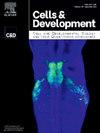The evolutionary and mechanical principles shaping the Drosophila embryonic ventral nerve cord
IF 3.9
4区 生物学
Q4 Biochemistry, Genetics and Molecular Biology
引用次数: 0
Abstract
The establishment of communication circuits requires bringing sources and targets into contact, either directly or indirectly. The Central Nervous System (CNS)'s ability to interpret the environment and generate precise responses depends on the functional efficiency of its neural network, which in turn relies on the 3D spatial organization of its constituents, mainly neurons and glia. Throughout evolution, sensory integration and motor response coordination became linked with the merging of the brain and nerve cord (NC) in the urbilaterian CNS. In most arthropods, the NC follows a specific topological plan and consists of a fixed number of neuromeres (thoracic and abdominal ganglia with commissural interconnections and a single terminal ganglion). The number, spacing, and fusion of neuromeres are species-specific and can change during embryogenesis or post-embryonic life. During Drosophila embryogenesis, the NC condenses along the Anterior-Posterior (AP) axis in a stereotypical manner, bringing neuromeres closer together. This process has revealed several key parameters, including its morphogenetic mechanics, the roles of various cellular, molecular, and structural components, and the functional purpose of its balanced design. The embryonic NC serves as a valuable model for investigating the ancient mechanisms underlying the structural organization, sensory integration, and motor coordination of the CNS. While many aspects of ganglionic fusion remain unknown, ongoing research promises to provide a more comprehensive understanding of the mechanical and evolutionary principles that govern it.
果蝇胚胎腹侧神经索的进化和机械原理。
通信回路的建立需要将信号源和目标直接或间接地联系起来。中枢神经系统(CNS)解读环境并做出精确反应的能力取决于其神经网络的功能效率,而神经网络的功能效率又取决于其组成成分(主要是神经元和神经胶质细胞)的三维空间组织。在整个进化过程中,感觉整合和运动反应协调随着近地中枢神经系统中大脑和神经索(NC)的合并而联系在一起。在大多数节肢动物中,NC 遵循特定的拓扑结构,由固定数量的神经元组成(胸神经节和腹神经节与神经节之间相互连接,并有一个末端神经节)。神经元的数量、间距和融合具有物种特异性,在胚胎发生或胚胎后期会发生变化。在果蝇胚胎发育过程中,NC沿前后(AP)轴以刻板的方式收缩,使神经元更紧密地结合在一起。这一过程揭示了几个关键参数,包括其形态发生机制,各种细胞、分子和结构成分的作用,以及其平衡设计的功能目的。胚胎数控系统是研究中枢神经系统的结构组织、感觉整合和运动协调的古老机制的宝贵模型。尽管神经节融合的许多方面仍不为人所知,但正在进行的研究有望让人们更全面地了解支配神经节融合的机械和进化原理。
本文章由计算机程序翻译,如有差异,请以英文原文为准。
求助全文
约1分钟内获得全文
求助全文
来源期刊

Cells and Development
Biochemistry, Genetics and Molecular Biology-Developmental Biology
CiteScore
2.90
自引率
0.00%
发文量
33
审稿时长
41 days
 求助内容:
求助内容: 应助结果提醒方式:
应助结果提醒方式:


